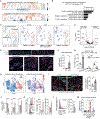NF-κB perturbation reveals unique immunomodulatory functions in Prx1+ fibroblasts that promote development of atopic dermatitis
- PMID: 35108061
- PMCID: PMC8979241
- DOI: 10.1126/scitranslmed.abj0324
NF-κB perturbation reveals unique immunomodulatory functions in Prx1+ fibroblasts that promote development of atopic dermatitis
Abstract
Skin is composed of diverse cell populations that cooperatively maintain homeostasis. Up-regulation of the nuclear factor κB (NF-κB) pathway may lead to the development of chronic inflammatory disorders of the skin, but its role during the early events remains unclear. Through analysis of single-cell RNA sequencing data via iterative random forest leave one out prediction, an explainable artificial intelligence method, we identified an immunoregulatory role for a unique paired related homeobox-1 (Prx1)+ fibroblast subpopulation. Disruption of Ikkb-NF-κB under homeostatic conditions in these fibroblasts paradoxically induced skin inflammation due to the overexpression of C-C motif chemokine ligand 11 (CCL11; or eotaxin-1) characterized by eosinophil infiltration and a subsequent TH2 immune response. Because the inflammatory phenotype resembled that seen in human atopic dermatitis (AD), we examined human AD skin samples and found that human AD fibroblasts also overexpressed CCL11 and that perturbation of Ikkb-NF-κB in primary human dermal fibroblasts up-regulated CCL11. Monoclonal antibody treatment against CCL11 was effective in reducing the eosinophilia and TH2 inflammation in a mouse model. Together, the murine model and human AD specimens point to dysregulated Prx1+ fibroblasts as a previously unrecognized etiologic factor that may contribute to the pathogenesis of AD and suggest that targeting CCL11 may be a way to treat AD-like skin lesions.
Conflict of interest statement
Figures








References
-
- Weidinger S, Beck LA, Bieber T, Kabashima K, Irvine AD, Atopic dermatitis. Nat Rev Dis Primers 4, 1 (2018). - PubMed
-
- Greb JE, Goldminz AM, Elder JT, Lebwohl MG, Gladman DD, Wu JJ, Mehta NN, Finlay AY, Gottlieb AB, Psoriasis. Nat Rev Dis Primers 2, 16082 (2016). - PubMed
-
- Arkwright PD, Motala C, Subramanian H, Spergel J, Schneider LC, Wollenberg A, Atopic A Dermatitis Working Group of the Allergic Skin Diseases Committee of the, Management of difficult-to-treat atopic dermatitis. J Allergy Clin Immunol Pract 1, 142–151 (2013). - PubMed
-
- Pasparakis M, Haase I, Nestle FO, Mechanisms regulating skin immunity and inflammation. Nat Rev Immunol 14, 289–301 (2014). - PubMed
Publication types
MeSH terms
Substances
Grants and funding
LinkOut - more resources
Full Text Sources
Other Literature Sources
Research Materials

